Organisational Theory and Practice: Thomas Cook Leadership Report
VerifiedAdded on 2023/01/10
|12
|3876
|31
Report
AI Summary
This report provides a detailed analysis of Thomas Cook's organizational theory and practice. It examines the management style of the CEO, identifying it as a democratic approach, and outlines the principles and functions of management employed. The report analyzes the organizational structure, which is a matrix structure, and the hierarchy-oriented culture of Thomas Cook, and their impact on employees. It describes the participative and transformational leadership styles of the CEO and their role in enhancing organizational effectiveness. The report also explores the effects of power, influence, and conflict within the firm and discusses the various types of motivation used. The analysis is supported by corporate examples and relevant literature, concluding with recommendations for improving organizational performance.
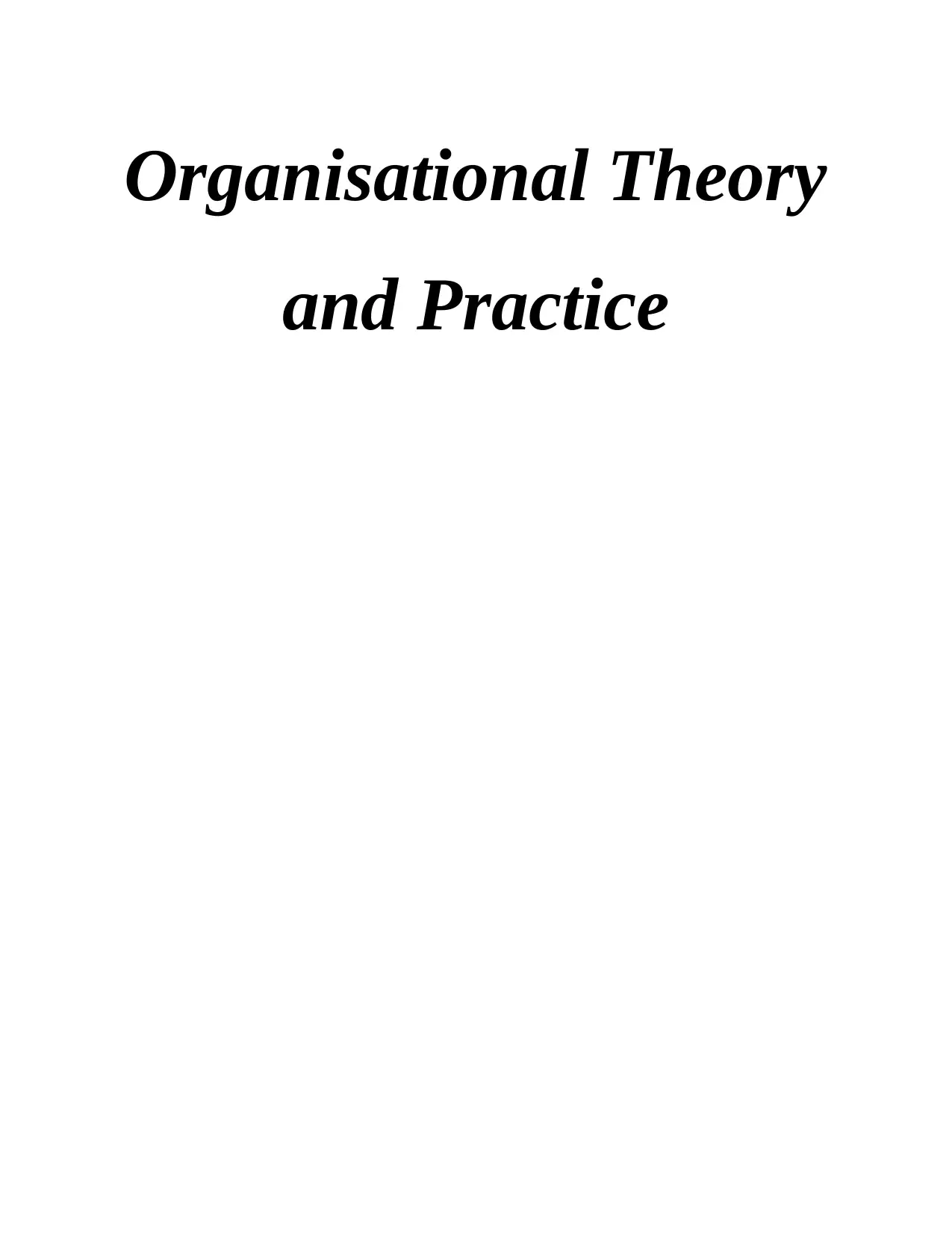
Organisational Theory
and Practice
and Practice
Paraphrase This Document
Need a fresh take? Get an instant paraphrase of this document with our AI Paraphraser
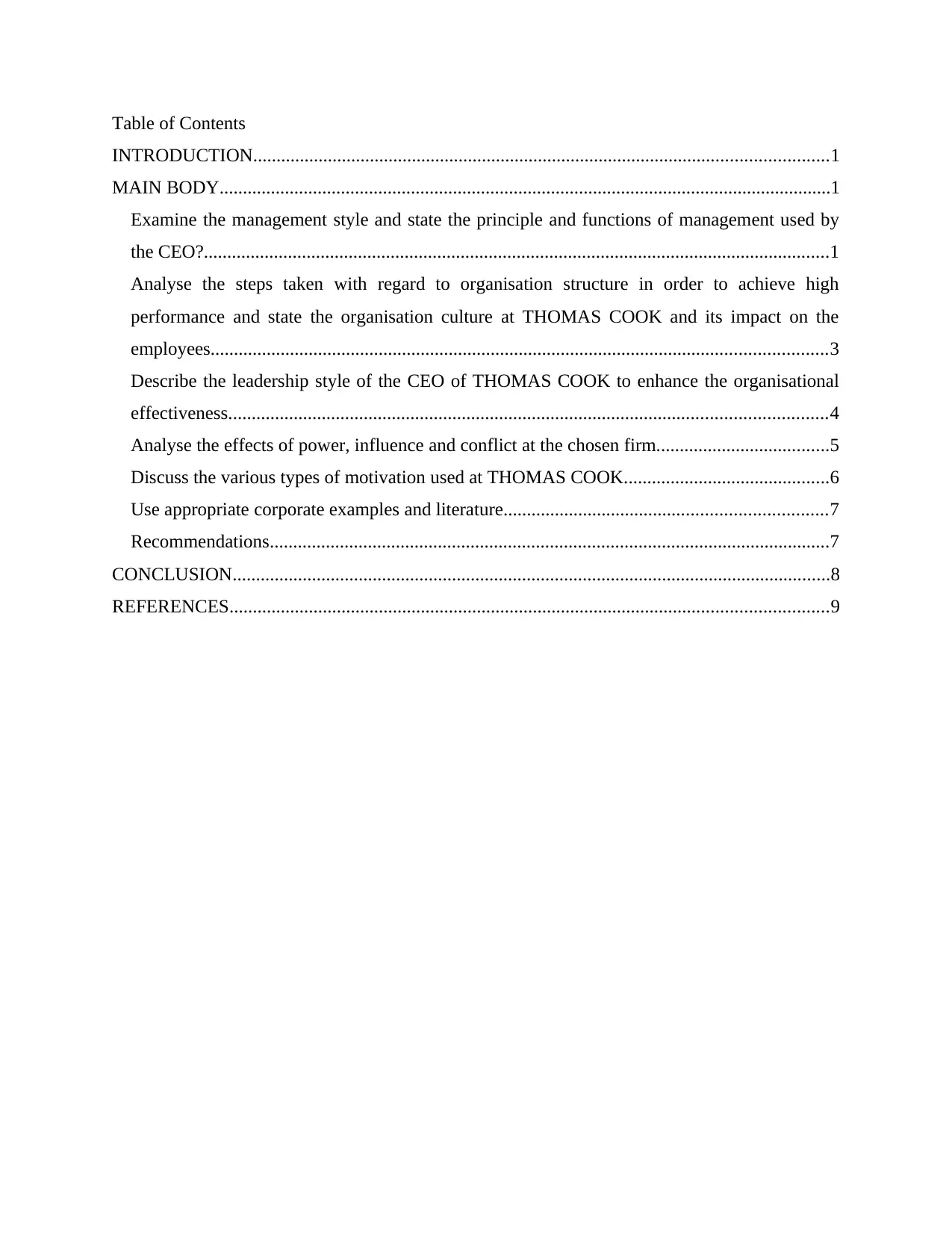
Table of Contents
INTRODUCTION...........................................................................................................................1
MAIN BODY...................................................................................................................................1
Examine the management style and state the principle and functions of management used by
the CEO?......................................................................................................................................1
Analyse the steps taken with regard to organisation structure in order to achieve high
performance and state the organisation culture at THOMAS COOK and its impact on the
employees....................................................................................................................................3
Describe the leadership style of the CEO of THOMAS COOK to enhance the organisational
effectiveness................................................................................................................................4
Analyse the effects of power, influence and conflict at the chosen firm.....................................5
Discuss the various types of motivation used at THOMAS COOK............................................6
Use appropriate corporate examples and literature.....................................................................7
Recommendations........................................................................................................................7
CONCLUSION................................................................................................................................8
REFERENCES................................................................................................................................9
INTRODUCTION...........................................................................................................................1
MAIN BODY...................................................................................................................................1
Examine the management style and state the principle and functions of management used by
the CEO?......................................................................................................................................1
Analyse the steps taken with regard to organisation structure in order to achieve high
performance and state the organisation culture at THOMAS COOK and its impact on the
employees....................................................................................................................................3
Describe the leadership style of the CEO of THOMAS COOK to enhance the organisational
effectiveness................................................................................................................................4
Analyse the effects of power, influence and conflict at the chosen firm.....................................5
Discuss the various types of motivation used at THOMAS COOK............................................6
Use appropriate corporate examples and literature.....................................................................7
Recommendations........................................................................................................................7
CONCLUSION................................................................................................................................8
REFERENCES................................................................................................................................9
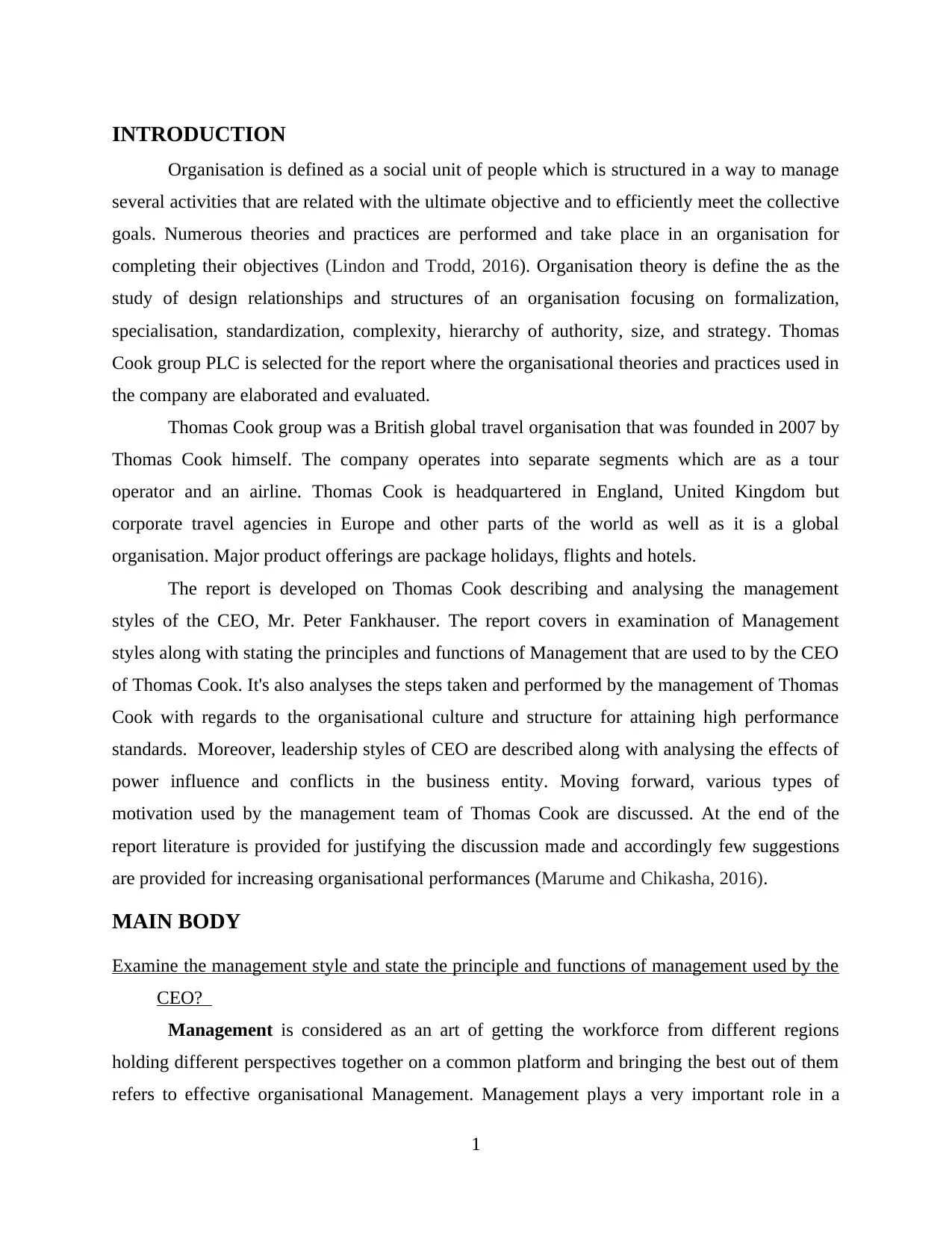
INTRODUCTION
Organisation is defined as a social unit of people which is structured in a way to manage
several activities that are related with the ultimate objective and to efficiently meet the collective
goals. Numerous theories and practices are performed and take place in an organisation for
completing their objectives (Lindon and Trodd, 2016). Organisation theory is define the as the
study of design relationships and structures of an organisation focusing on formalization,
specialisation, standardization, complexity, hierarchy of authority, size, and strategy. Thomas
Cook group PLC is selected for the report where the organisational theories and practices used in
the company are elaborated and evaluated.
Thomas Cook group was a British global travel organisation that was founded in 2007 by
Thomas Cook himself. The company operates into separate segments which are as a tour
operator and an airline. Thomas Cook is headquartered in England, United Kingdom but
corporate travel agencies in Europe and other parts of the world as well as it is a global
organisation. Major product offerings are package holidays, flights and hotels.
The report is developed on Thomas Cook describing and analysing the management
styles of the CEO, Mr. Peter Fankhauser. The report covers in examination of Management
styles along with stating the principles and functions of Management that are used to by the CEO
of Thomas Cook. It's also analyses the steps taken and performed by the management of Thomas
Cook with regards to the organisational culture and structure for attaining high performance
standards. Moreover, leadership styles of CEO are described along with analysing the effects of
power influence and conflicts in the business entity. Moving forward, various types of
motivation used by the management team of Thomas Cook are discussed. At the end of the
report literature is provided for justifying the discussion made and accordingly few suggestions
are provided for increasing organisational performances (Marume and Chikasha, 2016).
MAIN BODY
Examine the management style and state the principle and functions of management used by the
CEO?
Management is considered as an art of getting the workforce from different regions
holding different perspectives together on a common platform and bringing the best out of them
refers to effective organisational Management. Management plays a very important role in a
1
Organisation is defined as a social unit of people which is structured in a way to manage
several activities that are related with the ultimate objective and to efficiently meet the collective
goals. Numerous theories and practices are performed and take place in an organisation for
completing their objectives (Lindon and Trodd, 2016). Organisation theory is define the as the
study of design relationships and structures of an organisation focusing on formalization,
specialisation, standardization, complexity, hierarchy of authority, size, and strategy. Thomas
Cook group PLC is selected for the report where the organisational theories and practices used in
the company are elaborated and evaluated.
Thomas Cook group was a British global travel organisation that was founded in 2007 by
Thomas Cook himself. The company operates into separate segments which are as a tour
operator and an airline. Thomas Cook is headquartered in England, United Kingdom but
corporate travel agencies in Europe and other parts of the world as well as it is a global
organisation. Major product offerings are package holidays, flights and hotels.
The report is developed on Thomas Cook describing and analysing the management
styles of the CEO, Mr. Peter Fankhauser. The report covers in examination of Management
styles along with stating the principles and functions of Management that are used to by the CEO
of Thomas Cook. It's also analyses the steps taken and performed by the management of Thomas
Cook with regards to the organisational culture and structure for attaining high performance
standards. Moreover, leadership styles of CEO are described along with analysing the effects of
power influence and conflicts in the business entity. Moving forward, various types of
motivation used by the management team of Thomas Cook are discussed. At the end of the
report literature is provided for justifying the discussion made and accordingly few suggestions
are provided for increasing organisational performances (Marume and Chikasha, 2016).
MAIN BODY
Examine the management style and state the principle and functions of management used by the
CEO?
Management is considered as an art of getting the workforce from different regions
holding different perspectives together on a common platform and bringing the best out of them
refers to effective organisational Management. Management plays a very important role in a
1
⊘ This is a preview!⊘
Do you want full access?
Subscribe today to unlock all pages.

Trusted by 1+ million students worldwide
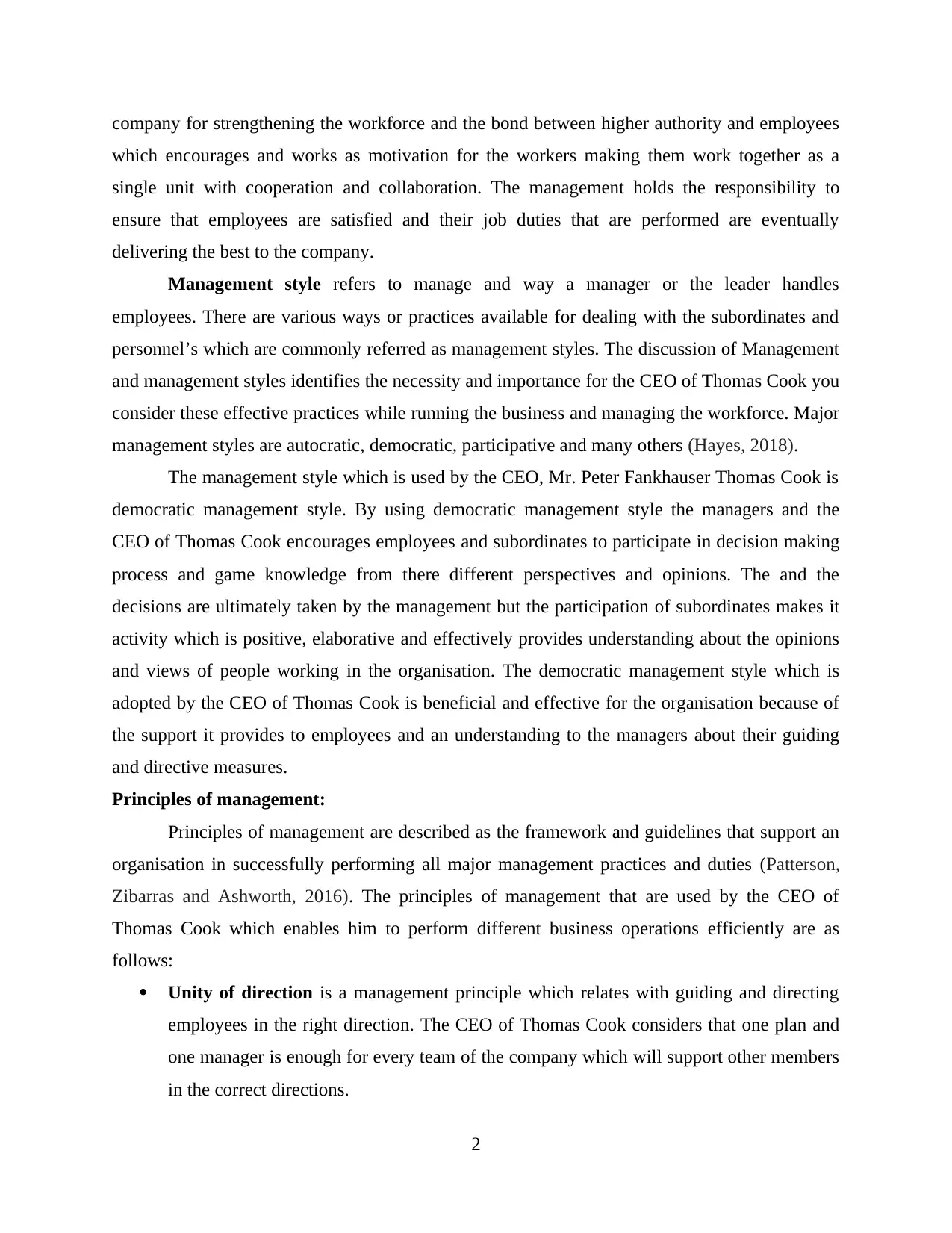
company for strengthening the workforce and the bond between higher authority and employees
which encourages and works as motivation for the workers making them work together as a
single unit with cooperation and collaboration. The management holds the responsibility to
ensure that employees are satisfied and their job duties that are performed are eventually
delivering the best to the company.
Management style refers to manage and way a manager or the leader handles
employees. There are various ways or practices available for dealing with the subordinates and
personnel’s which are commonly referred as management styles. The discussion of Management
and management styles identifies the necessity and importance for the CEO of Thomas Cook you
consider these effective practices while running the business and managing the workforce. Major
management styles are autocratic, democratic, participative and many others (Hayes, 2018).
The management style which is used by the CEO, Mr. Peter Fankhauser Thomas Cook is
democratic management style. By using democratic management style the managers and the
CEO of Thomas Cook encourages employees and subordinates to participate in decision making
process and game knowledge from there different perspectives and opinions. The and the
decisions are ultimately taken by the management but the participation of subordinates makes it
activity which is positive, elaborative and effectively provides understanding about the opinions
and views of people working in the organisation. The democratic management style which is
adopted by the CEO of Thomas Cook is beneficial and effective for the organisation because of
the support it provides to employees and an understanding to the managers about their guiding
and directive measures.
Principles of management:
Principles of management are described as the framework and guidelines that support an
organisation in successfully performing all major management practices and duties (Patterson,
Zibarras and Ashworth, 2016). The principles of management that are used by the CEO of
Thomas Cook which enables him to perform different business operations efficiently are as
follows:
Unity of direction is a management principle which relates with guiding and directing
employees in the right direction. The CEO of Thomas Cook considers that one plan and
one manager is enough for every team of the company which will support other members
in the correct directions.
2
which encourages and works as motivation for the workers making them work together as a
single unit with cooperation and collaboration. The management holds the responsibility to
ensure that employees are satisfied and their job duties that are performed are eventually
delivering the best to the company.
Management style refers to manage and way a manager or the leader handles
employees. There are various ways or practices available for dealing with the subordinates and
personnel’s which are commonly referred as management styles. The discussion of Management
and management styles identifies the necessity and importance for the CEO of Thomas Cook you
consider these effective practices while running the business and managing the workforce. Major
management styles are autocratic, democratic, participative and many others (Hayes, 2018).
The management style which is used by the CEO, Mr. Peter Fankhauser Thomas Cook is
democratic management style. By using democratic management style the managers and the
CEO of Thomas Cook encourages employees and subordinates to participate in decision making
process and game knowledge from there different perspectives and opinions. The and the
decisions are ultimately taken by the management but the participation of subordinates makes it
activity which is positive, elaborative and effectively provides understanding about the opinions
and views of people working in the organisation. The democratic management style which is
adopted by the CEO of Thomas Cook is beneficial and effective for the organisation because of
the support it provides to employees and an understanding to the managers about their guiding
and directive measures.
Principles of management:
Principles of management are described as the framework and guidelines that support an
organisation in successfully performing all major management practices and duties (Patterson,
Zibarras and Ashworth, 2016). The principles of management that are used by the CEO of
Thomas Cook which enables him to perform different business operations efficiently are as
follows:
Unity of direction is a management principle which relates with guiding and directing
employees in the right direction. The CEO of Thomas Cook considers that one plan and
one manager is enough for every team of the company which will support other members
in the correct directions.
2
Paraphrase This Document
Need a fresh take? Get an instant paraphrase of this document with our AI Paraphraser
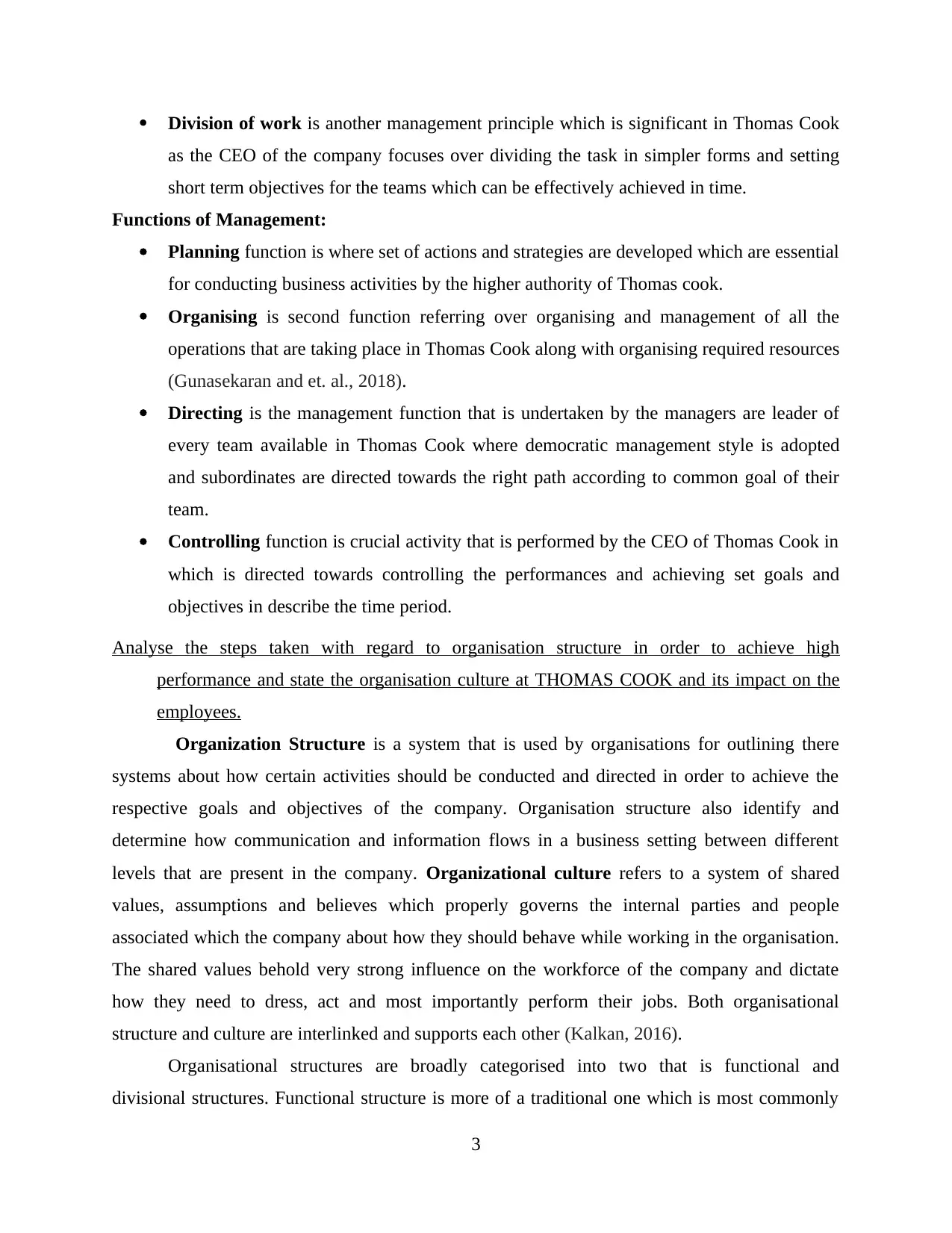
Division of work is another management principle which is significant in Thomas Cook
as the CEO of the company focuses over dividing the task in simpler forms and setting
short term objectives for the teams which can be effectively achieved in time.
Functions of Management:
Planning function is where set of actions and strategies are developed which are essential
for conducting business activities by the higher authority of Thomas cook.
Organising is second function referring over organising and management of all the
operations that are taking place in Thomas Cook along with organising required resources
(Gunasekaran and et. al., 2018).
Directing is the management function that is undertaken by the managers are leader of
every team available in Thomas Cook where democratic management style is adopted
and subordinates are directed towards the right path according to common goal of their
team.
Controlling function is crucial activity that is performed by the CEO of Thomas Cook in
which is directed towards controlling the performances and achieving set goals and
objectives in describe the time period.
Analyse the steps taken with regard to organisation structure in order to achieve high
performance and state the organisation culture at THOMAS COOK and its impact on the
employees.
Organization Structure is a system that is used by organisations for outlining there
systems about how certain activities should be conducted and directed in order to achieve the
respective goals and objectives of the company. Organisation structure also identify and
determine how communication and information flows in a business setting between different
levels that are present in the company. Organizational culture refers to a system of shared
values, assumptions and believes which properly governs the internal parties and people
associated which the company about how they should behave while working in the organisation.
The shared values behold very strong influence on the workforce of the company and dictate
how they need to dress, act and most importantly perform their jobs. Both organisational
structure and culture are interlinked and supports each other (Kalkan, 2016).
Organisational structures are broadly categorised into two that is functional and
divisional structures. Functional structure is more of a traditional one which is most commonly
3
as the CEO of the company focuses over dividing the task in simpler forms and setting
short term objectives for the teams which can be effectively achieved in time.
Functions of Management:
Planning function is where set of actions and strategies are developed which are essential
for conducting business activities by the higher authority of Thomas cook.
Organising is second function referring over organising and management of all the
operations that are taking place in Thomas Cook along with organising required resources
(Gunasekaran and et. al., 2018).
Directing is the management function that is undertaken by the managers are leader of
every team available in Thomas Cook where democratic management style is adopted
and subordinates are directed towards the right path according to common goal of their
team.
Controlling function is crucial activity that is performed by the CEO of Thomas Cook in
which is directed towards controlling the performances and achieving set goals and
objectives in describe the time period.
Analyse the steps taken with regard to organisation structure in order to achieve high
performance and state the organisation culture at THOMAS COOK and its impact on the
employees.
Organization Structure is a system that is used by organisations for outlining there
systems about how certain activities should be conducted and directed in order to achieve the
respective goals and objectives of the company. Organisation structure also identify and
determine how communication and information flows in a business setting between different
levels that are present in the company. Organizational culture refers to a system of shared
values, assumptions and believes which properly governs the internal parties and people
associated which the company about how they should behave while working in the organisation.
The shared values behold very strong influence on the workforce of the company and dictate
how they need to dress, act and most importantly perform their jobs. Both organisational
structure and culture are interlinked and supports each other (Kalkan, 2016).
Organisational structures are broadly categorised into two that is functional and
divisional structures. Functional structure is more of a traditional one which is most commonly
3
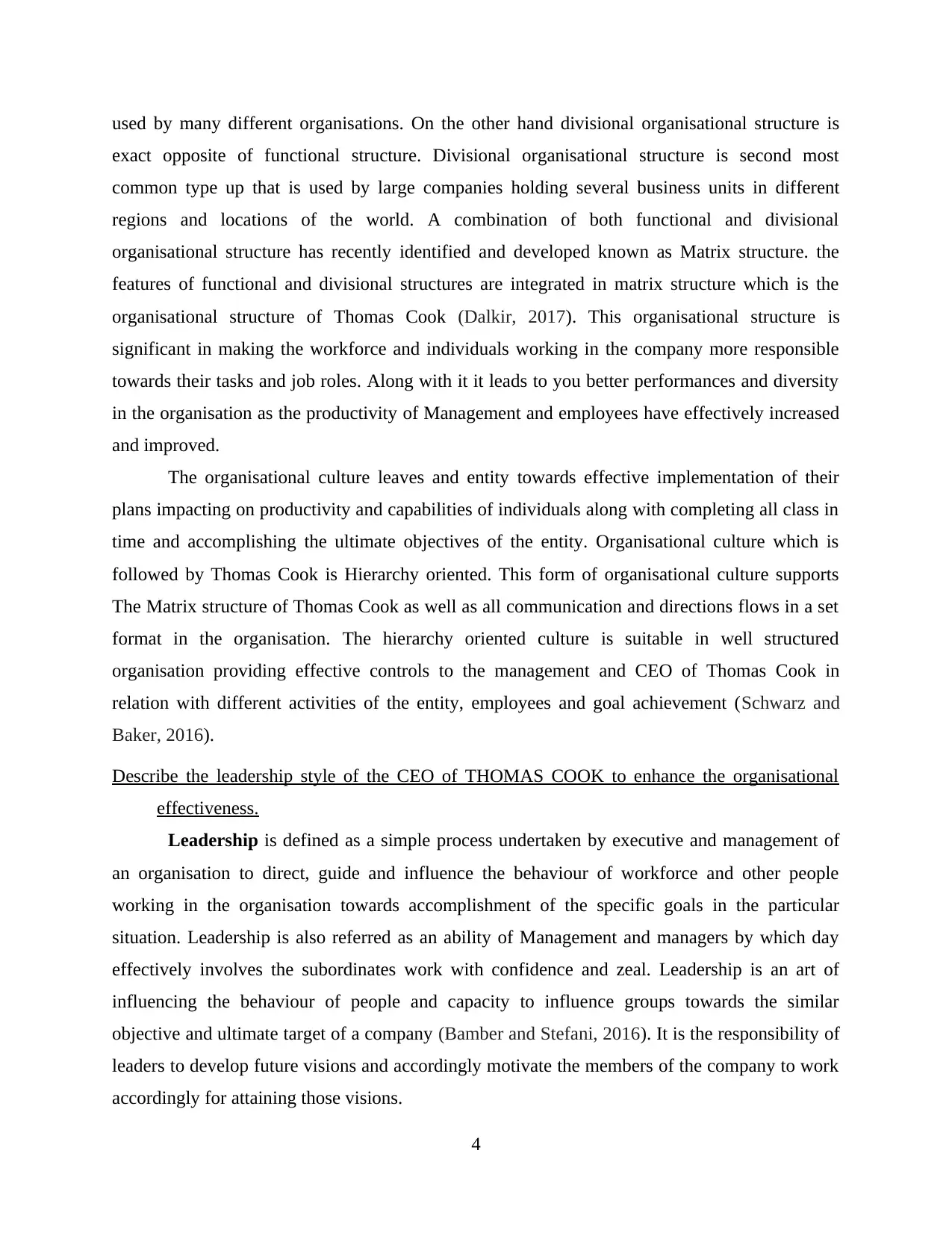
used by many different organisations. On the other hand divisional organisational structure is
exact opposite of functional structure. Divisional organisational structure is second most
common type up that is used by large companies holding several business units in different
regions and locations of the world. A combination of both functional and divisional
organisational structure has recently identified and developed known as Matrix structure. the
features of functional and divisional structures are integrated in matrix structure which is the
organisational structure of Thomas Cook (Dalkir, 2017). This organisational structure is
significant in making the workforce and individuals working in the company more responsible
towards their tasks and job roles. Along with it it leads to you better performances and diversity
in the organisation as the productivity of Management and employees have effectively increased
and improved.
The organisational culture leaves and entity towards effective implementation of their
plans impacting on productivity and capabilities of individuals along with completing all class in
time and accomplishing the ultimate objectives of the entity. Organisational culture which is
followed by Thomas Cook is Hierarchy oriented. This form of organisational culture supports
The Matrix structure of Thomas Cook as well as all communication and directions flows in a set
format in the organisation. The hierarchy oriented culture is suitable in well structured
organisation providing effective controls to the management and CEO of Thomas Cook in
relation with different activities of the entity, employees and goal achievement (Schwarz and
Baker, 2016).
Describe the leadership style of the CEO of THOMAS COOK to enhance the organisational
effectiveness.
Leadership is defined as a simple process undertaken by executive and management of
an organisation to direct, guide and influence the behaviour of workforce and other people
working in the organisation towards accomplishment of the specific goals in the particular
situation. Leadership is also referred as an ability of Management and managers by which day
effectively involves the subordinates work with confidence and zeal. Leadership is an art of
influencing the behaviour of people and capacity to influence groups towards the similar
objective and ultimate target of a company (Bamber and Stefani, 2016). It is the responsibility of
leaders to develop future visions and accordingly motivate the members of the company to work
accordingly for attaining those visions.
4
exact opposite of functional structure. Divisional organisational structure is second most
common type up that is used by large companies holding several business units in different
regions and locations of the world. A combination of both functional and divisional
organisational structure has recently identified and developed known as Matrix structure. the
features of functional and divisional structures are integrated in matrix structure which is the
organisational structure of Thomas Cook (Dalkir, 2017). This organisational structure is
significant in making the workforce and individuals working in the company more responsible
towards their tasks and job roles. Along with it it leads to you better performances and diversity
in the organisation as the productivity of Management and employees have effectively increased
and improved.
The organisational culture leaves and entity towards effective implementation of their
plans impacting on productivity and capabilities of individuals along with completing all class in
time and accomplishing the ultimate objectives of the entity. Organisational culture which is
followed by Thomas Cook is Hierarchy oriented. This form of organisational culture supports
The Matrix structure of Thomas Cook as well as all communication and directions flows in a set
format in the organisation. The hierarchy oriented culture is suitable in well structured
organisation providing effective controls to the management and CEO of Thomas Cook in
relation with different activities of the entity, employees and goal achievement (Schwarz and
Baker, 2016).
Describe the leadership style of the CEO of THOMAS COOK to enhance the organisational
effectiveness.
Leadership is defined as a simple process undertaken by executive and management of
an organisation to direct, guide and influence the behaviour of workforce and other people
working in the organisation towards accomplishment of the specific goals in the particular
situation. Leadership is also referred as an ability of Management and managers by which day
effectively involves the subordinates work with confidence and zeal. Leadership is an art of
influencing the behaviour of people and capacity to influence groups towards the similar
objective and ultimate target of a company (Bamber and Stefani, 2016). It is the responsibility of
leaders to develop future visions and accordingly motivate the members of the company to work
accordingly for attaining those visions.
4
⊘ This is a preview!⊘
Do you want full access?
Subscribe today to unlock all pages.

Trusted by 1+ million students worldwide
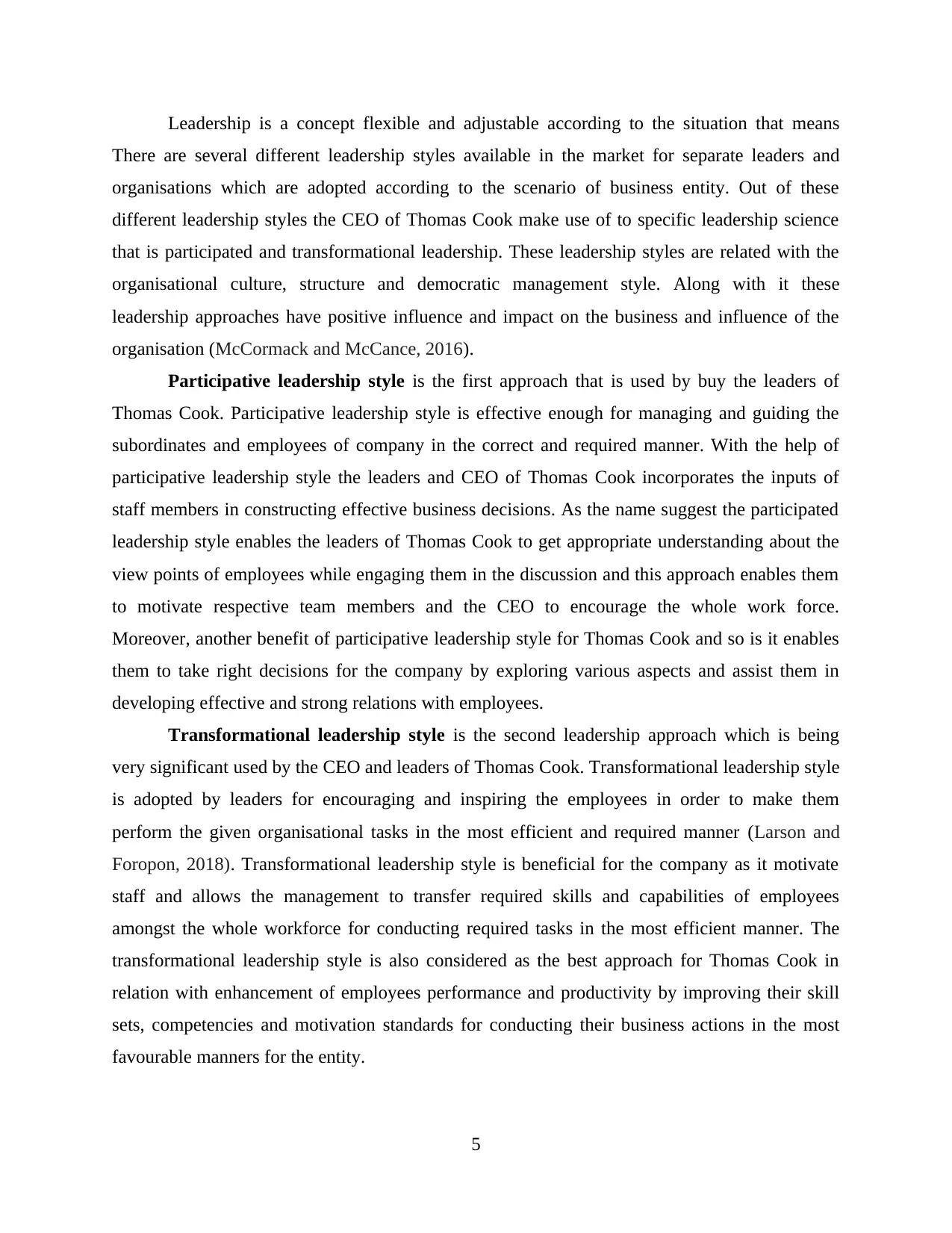
Leadership is a concept flexible and adjustable according to the situation that means
There are several different leadership styles available in the market for separate leaders and
organisations which are adopted according to the scenario of business entity. Out of these
different leadership styles the CEO of Thomas Cook make use of to specific leadership science
that is participated and transformational leadership. These leadership styles are related with the
organisational culture, structure and democratic management style. Along with it these
leadership approaches have positive influence and impact on the business and influence of the
organisation (McCormack and McCance, 2016).
Participative leadership style is the first approach that is used by buy the leaders of
Thomas Cook. Participative leadership style is effective enough for managing and guiding the
subordinates and employees of company in the correct and required manner. With the help of
participative leadership style the leaders and CEO of Thomas Cook incorporates the inputs of
staff members in constructing effective business decisions. As the name suggest the participated
leadership style enables the leaders of Thomas Cook to get appropriate understanding about the
view points of employees while engaging them in the discussion and this approach enables them
to motivate respective team members and the CEO to encourage the whole work force.
Moreover, another benefit of participative leadership style for Thomas Cook and so is it enables
them to take right decisions for the company by exploring various aspects and assist them in
developing effective and strong relations with employees.
Transformational leadership style is the second leadership approach which is being
very significant used by the CEO and leaders of Thomas Cook. Transformational leadership style
is adopted by leaders for encouraging and inspiring the employees in order to make them
perform the given organisational tasks in the most efficient and required manner (Larson and
Foropon, 2018). Transformational leadership style is beneficial for the company as it motivate
staff and allows the management to transfer required skills and capabilities of employees
amongst the whole workforce for conducting required tasks in the most efficient manner. The
transformational leadership style is also considered as the best approach for Thomas Cook in
relation with enhancement of employees performance and productivity by improving their skill
sets, competencies and motivation standards for conducting their business actions in the most
favourable manners for the entity.
5
There are several different leadership styles available in the market for separate leaders and
organisations which are adopted according to the scenario of business entity. Out of these
different leadership styles the CEO of Thomas Cook make use of to specific leadership science
that is participated and transformational leadership. These leadership styles are related with the
organisational culture, structure and democratic management style. Along with it these
leadership approaches have positive influence and impact on the business and influence of the
organisation (McCormack and McCance, 2016).
Participative leadership style is the first approach that is used by buy the leaders of
Thomas Cook. Participative leadership style is effective enough for managing and guiding the
subordinates and employees of company in the correct and required manner. With the help of
participative leadership style the leaders and CEO of Thomas Cook incorporates the inputs of
staff members in constructing effective business decisions. As the name suggest the participated
leadership style enables the leaders of Thomas Cook to get appropriate understanding about the
view points of employees while engaging them in the discussion and this approach enables them
to motivate respective team members and the CEO to encourage the whole work force.
Moreover, another benefit of participative leadership style for Thomas Cook and so is it enables
them to take right decisions for the company by exploring various aspects and assist them in
developing effective and strong relations with employees.
Transformational leadership style is the second leadership approach which is being
very significant used by the CEO and leaders of Thomas Cook. Transformational leadership style
is adopted by leaders for encouraging and inspiring the employees in order to make them
perform the given organisational tasks in the most efficient and required manner (Larson and
Foropon, 2018). Transformational leadership style is beneficial for the company as it motivate
staff and allows the management to transfer required skills and capabilities of employees
amongst the whole workforce for conducting required tasks in the most efficient manner. The
transformational leadership style is also considered as the best approach for Thomas Cook in
relation with enhancement of employees performance and productivity by improving their skill
sets, competencies and motivation standards for conducting their business actions in the most
favourable manners for the entity.
5
Paraphrase This Document
Need a fresh take? Get an instant paraphrase of this document with our AI Paraphraser
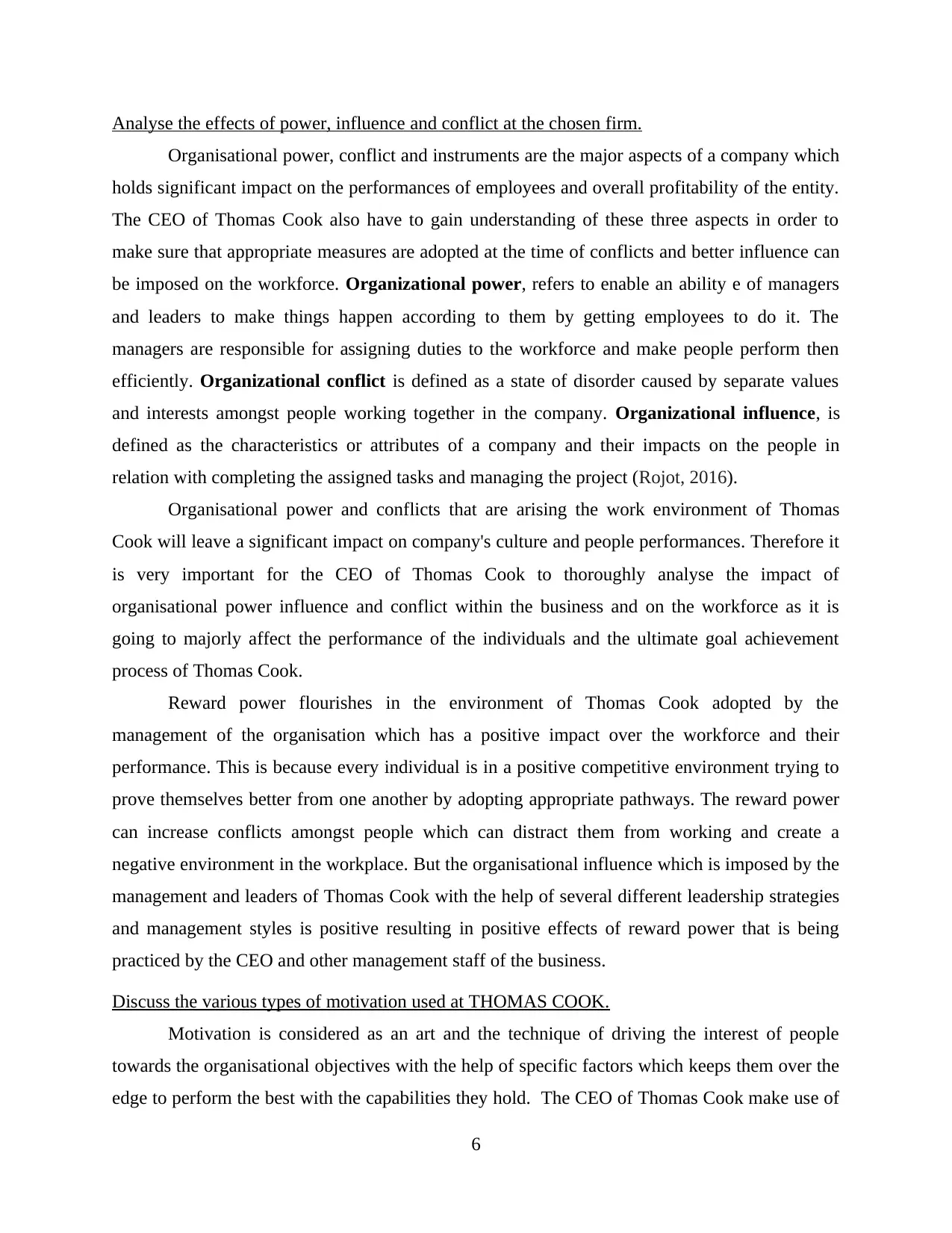
Analyse the effects of power, influence and conflict at the chosen firm.
Organisational power, conflict and instruments are the major aspects of a company which
holds significant impact on the performances of employees and overall profitability of the entity.
The CEO of Thomas Cook also have to gain understanding of these three aspects in order to
make sure that appropriate measures are adopted at the time of conflicts and better influence can
be imposed on the workforce. Organizational power, refers to enable an ability e of managers
and leaders to make things happen according to them by getting employees to do it. The
managers are responsible for assigning duties to the workforce and make people perform then
efficiently. Organizational conflict is defined as a state of disorder caused by separate values
and interests amongst people working together in the company. Organizational influence, is
defined as the characteristics or attributes of a company and their impacts on the people in
relation with completing the assigned tasks and managing the project (Rojot, 2016).
Organisational power and conflicts that are arising the work environment of Thomas
Cook will leave a significant impact on company's culture and people performances. Therefore it
is very important for the CEO of Thomas Cook to thoroughly analyse the impact of
organisational power influence and conflict within the business and on the workforce as it is
going to majorly affect the performance of the individuals and the ultimate goal achievement
process of Thomas Cook.
Reward power flourishes in the environment of Thomas Cook adopted by the
management of the organisation which has a positive impact over the workforce and their
performance. This is because every individual is in a positive competitive environment trying to
prove themselves better from one another by adopting appropriate pathways. The reward power
can increase conflicts amongst people which can distract them from working and create a
negative environment in the workplace. But the organisational influence which is imposed by the
management and leaders of Thomas Cook with the help of several different leadership strategies
and management styles is positive resulting in positive effects of reward power that is being
practiced by the CEO and other management staff of the business.
Discuss the various types of motivation used at THOMAS COOK.
Motivation is considered as an art and the technique of driving the interest of people
towards the organisational objectives with the help of specific factors which keeps them over the
edge to perform the best with the capabilities they hold. The CEO of Thomas Cook make use of
6
Organisational power, conflict and instruments are the major aspects of a company which
holds significant impact on the performances of employees and overall profitability of the entity.
The CEO of Thomas Cook also have to gain understanding of these three aspects in order to
make sure that appropriate measures are adopted at the time of conflicts and better influence can
be imposed on the workforce. Organizational power, refers to enable an ability e of managers
and leaders to make things happen according to them by getting employees to do it. The
managers are responsible for assigning duties to the workforce and make people perform then
efficiently. Organizational conflict is defined as a state of disorder caused by separate values
and interests amongst people working together in the company. Organizational influence, is
defined as the characteristics or attributes of a company and their impacts on the people in
relation with completing the assigned tasks and managing the project (Rojot, 2016).
Organisational power and conflicts that are arising the work environment of Thomas
Cook will leave a significant impact on company's culture and people performances. Therefore it
is very important for the CEO of Thomas Cook to thoroughly analyse the impact of
organisational power influence and conflict within the business and on the workforce as it is
going to majorly affect the performance of the individuals and the ultimate goal achievement
process of Thomas Cook.
Reward power flourishes in the environment of Thomas Cook adopted by the
management of the organisation which has a positive impact over the workforce and their
performance. This is because every individual is in a positive competitive environment trying to
prove themselves better from one another by adopting appropriate pathways. The reward power
can increase conflicts amongst people which can distract them from working and create a
negative environment in the workplace. But the organisational influence which is imposed by the
management and leaders of Thomas Cook with the help of several different leadership strategies
and management styles is positive resulting in positive effects of reward power that is being
practiced by the CEO and other management staff of the business.
Discuss the various types of motivation used at THOMAS COOK.
Motivation is considered as an art and the technique of driving the interest of people
towards the organisational objectives with the help of specific factors which keeps them over the
edge to perform the best with the capabilities they hold. The CEO of Thomas Cook make use of
6
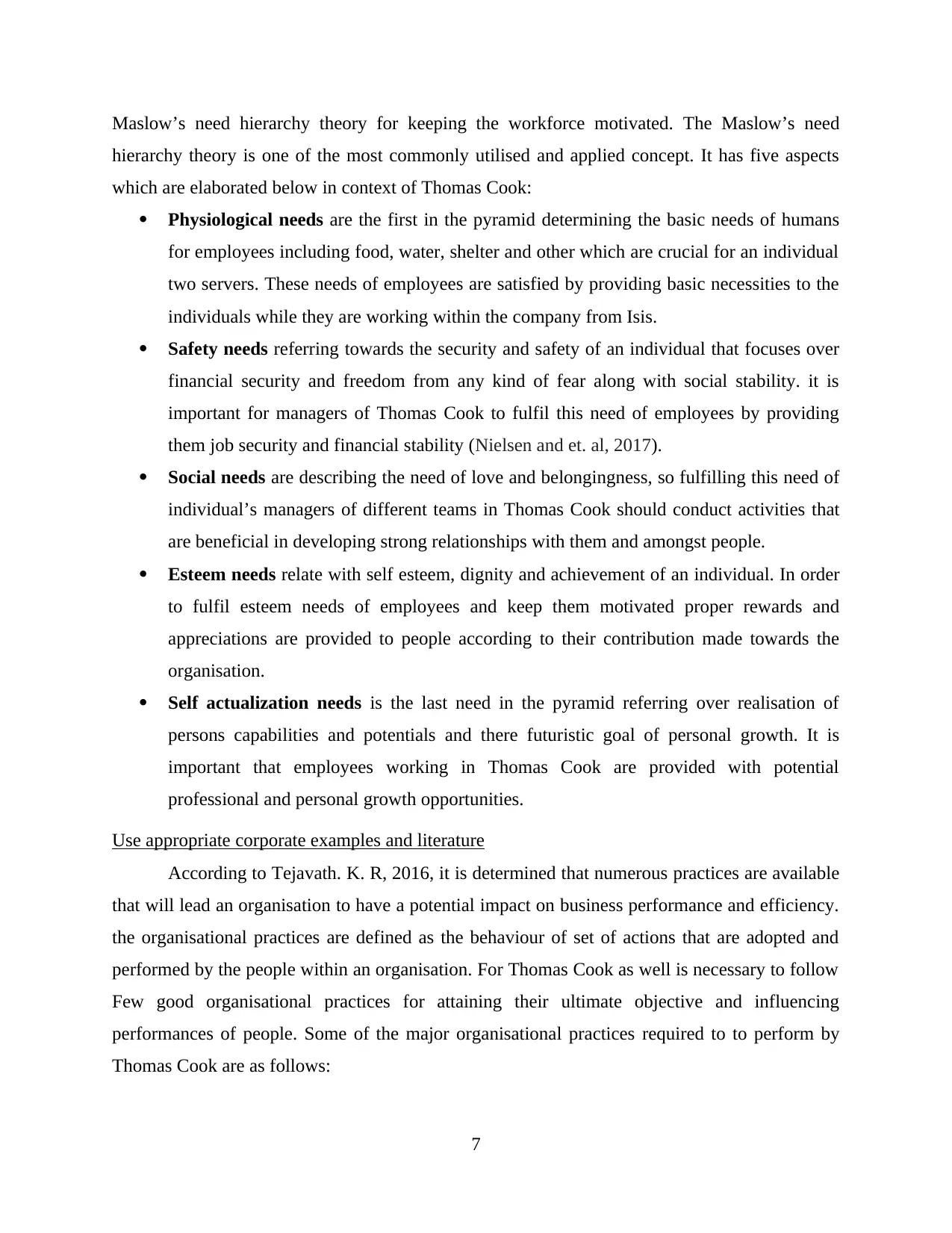
Maslow’s need hierarchy theory for keeping the workforce motivated. The Maslow’s need
hierarchy theory is one of the most commonly utilised and applied concept. It has five aspects
which are elaborated below in context of Thomas Cook:
Physiological needs are the first in the pyramid determining the basic needs of humans
for employees including food, water, shelter and other which are crucial for an individual
two servers. These needs of employees are satisfied by providing basic necessities to the
individuals while they are working within the company from Isis.
Safety needs referring towards the security and safety of an individual that focuses over
financial security and freedom from any kind of fear along with social stability. it is
important for managers of Thomas Cook to fulfil this need of employees by providing
them job security and financial stability (Nielsen and et. al, 2017).
Social needs are describing the need of love and belongingness, so fulfilling this need of
individual’s managers of different teams in Thomas Cook should conduct activities that
are beneficial in developing strong relationships with them and amongst people.
Esteem needs relate with self esteem, dignity and achievement of an individual. In order
to fulfil esteem needs of employees and keep them motivated proper rewards and
appreciations are provided to people according to their contribution made towards the
organisation.
Self actualization needs is the last need in the pyramid referring over realisation of
persons capabilities and potentials and there futuristic goal of personal growth. It is
important that employees working in Thomas Cook are provided with potential
professional and personal growth opportunities.
Use appropriate corporate examples and literature
According to Tejavath. K. R, 2016, it is determined that numerous practices are available
that will lead an organisation to have a potential impact on business performance and efficiency.
the organisational practices are defined as the behaviour of set of actions that are adopted and
performed by the people within an organisation. For Thomas Cook as well is necessary to follow
Few good organisational practices for attaining their ultimate objective and influencing
performances of people. Some of the major organisational practices required to to perform by
Thomas Cook are as follows:
7
hierarchy theory is one of the most commonly utilised and applied concept. It has five aspects
which are elaborated below in context of Thomas Cook:
Physiological needs are the first in the pyramid determining the basic needs of humans
for employees including food, water, shelter and other which are crucial for an individual
two servers. These needs of employees are satisfied by providing basic necessities to the
individuals while they are working within the company from Isis.
Safety needs referring towards the security and safety of an individual that focuses over
financial security and freedom from any kind of fear along with social stability. it is
important for managers of Thomas Cook to fulfil this need of employees by providing
them job security and financial stability (Nielsen and et. al, 2017).
Social needs are describing the need of love and belongingness, so fulfilling this need of
individual’s managers of different teams in Thomas Cook should conduct activities that
are beneficial in developing strong relationships with them and amongst people.
Esteem needs relate with self esteem, dignity and achievement of an individual. In order
to fulfil esteem needs of employees and keep them motivated proper rewards and
appreciations are provided to people according to their contribution made towards the
organisation.
Self actualization needs is the last need in the pyramid referring over realisation of
persons capabilities and potentials and there futuristic goal of personal growth. It is
important that employees working in Thomas Cook are provided with potential
professional and personal growth opportunities.
Use appropriate corporate examples and literature
According to Tejavath. K. R, 2016, it is determined that numerous practices are available
that will lead an organisation to have a potential impact on business performance and efficiency.
the organisational practices are defined as the behaviour of set of actions that are adopted and
performed by the people within an organisation. For Thomas Cook as well is necessary to follow
Few good organisational practices for attaining their ultimate objective and influencing
performances of people. Some of the major organisational practices required to to perform by
Thomas Cook are as follows:
7
⊘ This is a preview!⊘
Do you want full access?
Subscribe today to unlock all pages.

Trusted by 1+ million students worldwide
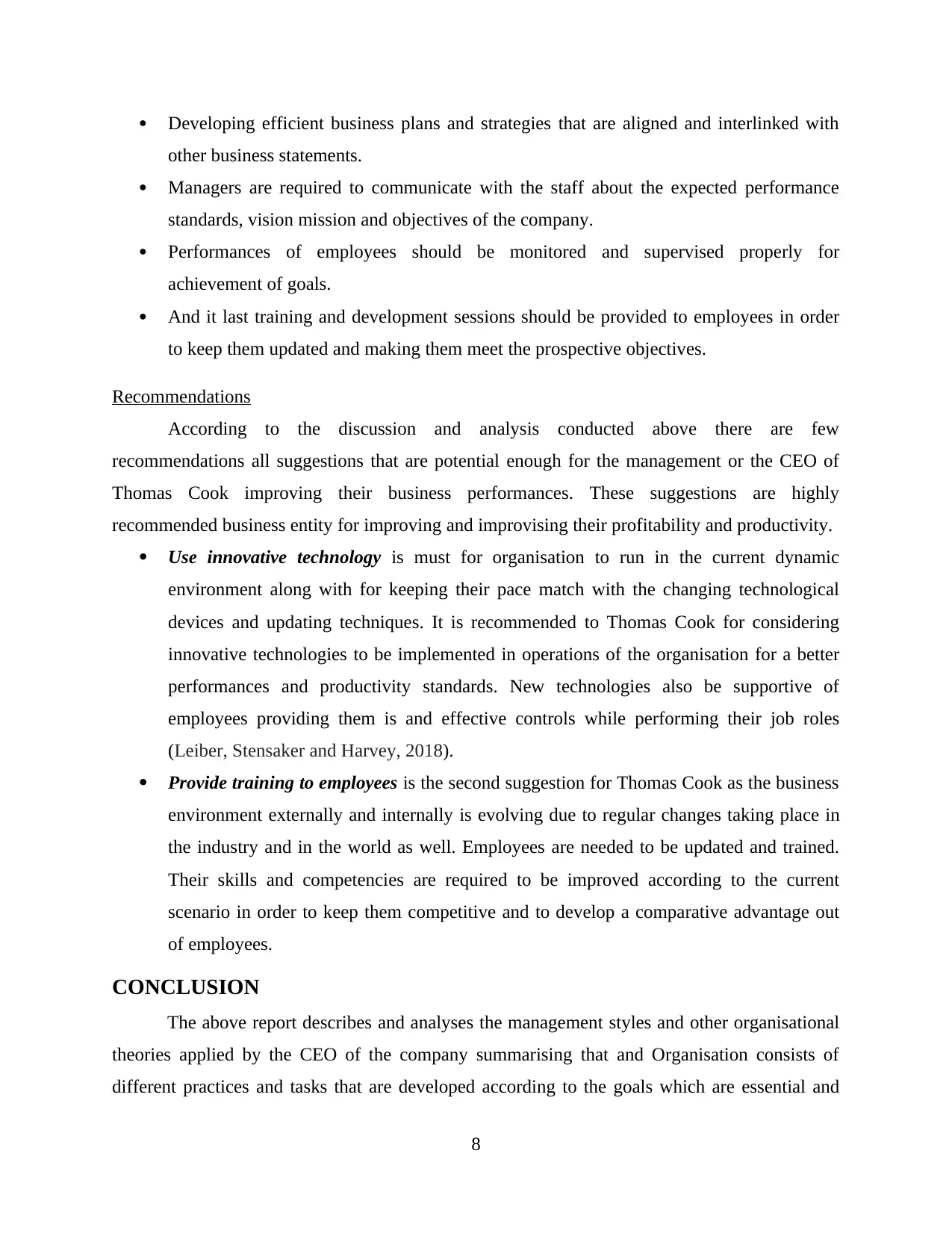
Developing efficient business plans and strategies that are aligned and interlinked with
other business statements.
Managers are required to communicate with the staff about the expected performance
standards, vision mission and objectives of the company.
Performances of employees should be monitored and supervised properly for
achievement of goals.
And it last training and development sessions should be provided to employees in order
to keep them updated and making them meet the prospective objectives.
Recommendations
According to the discussion and analysis conducted above there are few
recommendations all suggestions that are potential enough for the management or the CEO of
Thomas Cook improving their business performances. These suggestions are highly
recommended business entity for improving and improvising their profitability and productivity.
Use innovative technology is must for organisation to run in the current dynamic
environment along with for keeping their pace match with the changing technological
devices and updating techniques. It is recommended to Thomas Cook for considering
innovative technologies to be implemented in operations of the organisation for a better
performances and productivity standards. New technologies also be supportive of
employees providing them is and effective controls while performing their job roles
(Leiber, Stensaker and Harvey, 2018).
Provide training to employees is the second suggestion for Thomas Cook as the business
environment externally and internally is evolving due to regular changes taking place in
the industry and in the world as well. Employees are needed to be updated and trained.
Their skills and competencies are required to be improved according to the current
scenario in order to keep them competitive and to develop a comparative advantage out
of employees.
CONCLUSION
The above report describes and analyses the management styles and other organisational
theories applied by the CEO of the company summarising that and Organisation consists of
different practices and tasks that are developed according to the goals which are essential and
8
other business statements.
Managers are required to communicate with the staff about the expected performance
standards, vision mission and objectives of the company.
Performances of employees should be monitored and supervised properly for
achievement of goals.
And it last training and development sessions should be provided to employees in order
to keep them updated and making them meet the prospective objectives.
Recommendations
According to the discussion and analysis conducted above there are few
recommendations all suggestions that are potential enough for the management or the CEO of
Thomas Cook improving their business performances. These suggestions are highly
recommended business entity for improving and improvising their profitability and productivity.
Use innovative technology is must for organisation to run in the current dynamic
environment along with for keeping their pace match with the changing technological
devices and updating techniques. It is recommended to Thomas Cook for considering
innovative technologies to be implemented in operations of the organisation for a better
performances and productivity standards. New technologies also be supportive of
employees providing them is and effective controls while performing their job roles
(Leiber, Stensaker and Harvey, 2018).
Provide training to employees is the second suggestion for Thomas Cook as the business
environment externally and internally is evolving due to regular changes taking place in
the industry and in the world as well. Employees are needed to be updated and trained.
Their skills and competencies are required to be improved according to the current
scenario in order to keep them competitive and to develop a comparative advantage out
of employees.
CONCLUSION
The above report describes and analyses the management styles and other organisational
theories applied by the CEO of the company summarising that and Organisation consists of
different practices and tasks that are developed according to the goals which are essential and
8
Paraphrase This Document
Need a fresh take? Get an instant paraphrase of this document with our AI Paraphraser
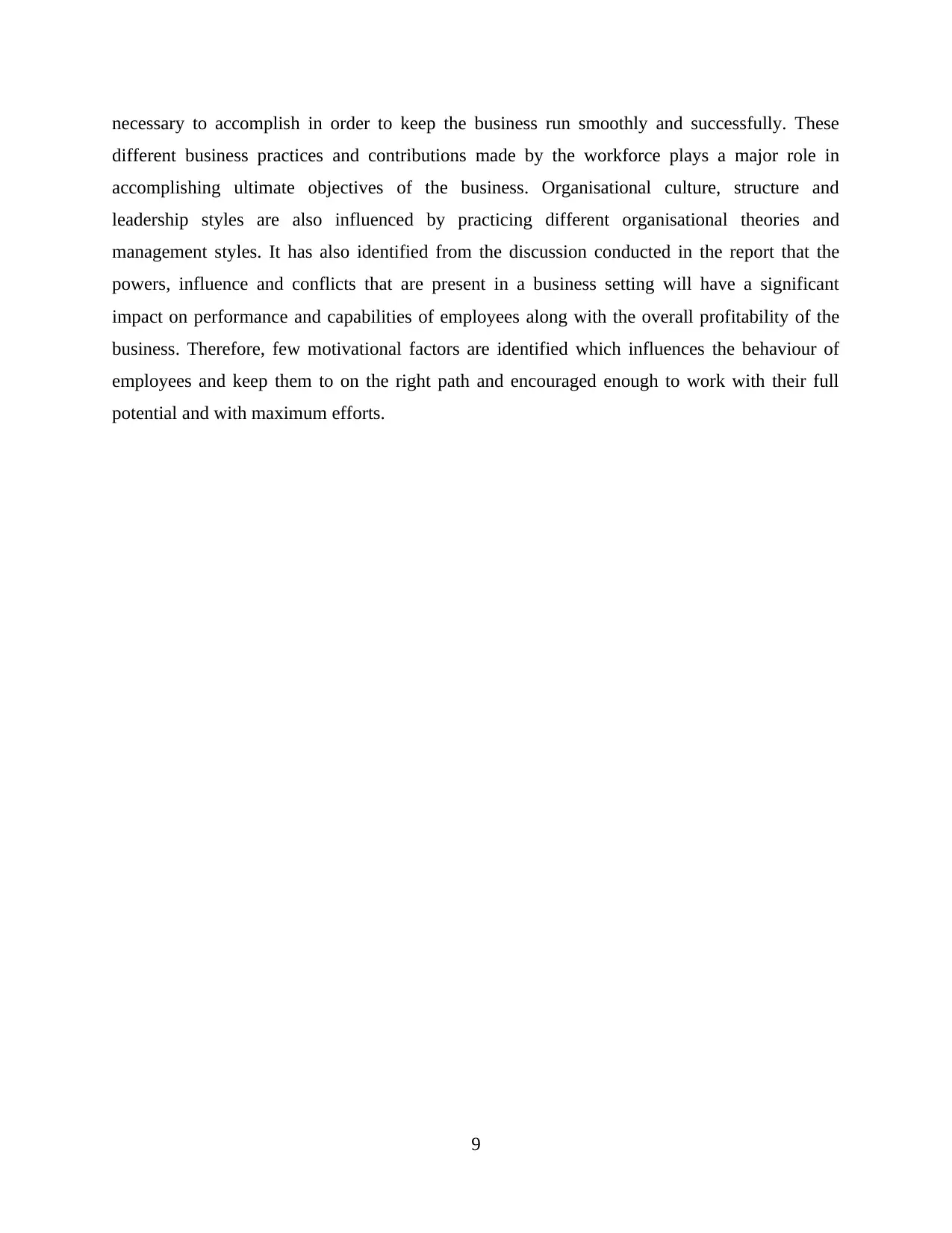
necessary to accomplish in order to keep the business run smoothly and successfully. These
different business practices and contributions made by the workforce plays a major role in
accomplishing ultimate objectives of the business. Organisational culture, structure and
leadership styles are also influenced by practicing different organisational theories and
management styles. It has also identified from the discussion conducted in the report that the
powers, influence and conflicts that are present in a business setting will have a significant
impact on performance and capabilities of employees along with the overall profitability of the
business. Therefore, few motivational factors are identified which influences the behaviour of
employees and keep them to on the right path and encouraged enough to work with their full
potential and with maximum efforts.
9
different business practices and contributions made by the workforce plays a major role in
accomplishing ultimate objectives of the business. Organisational culture, structure and
leadership styles are also influenced by practicing different organisational theories and
management styles. It has also identified from the discussion conducted in the report that the
powers, influence and conflicts that are present in a business setting will have a significant
impact on performance and capabilities of employees along with the overall profitability of the
business. Therefore, few motivational factors are identified which influences the behaviour of
employees and keep them to on the right path and encouraged enough to work with their full
potential and with maximum efforts.
9
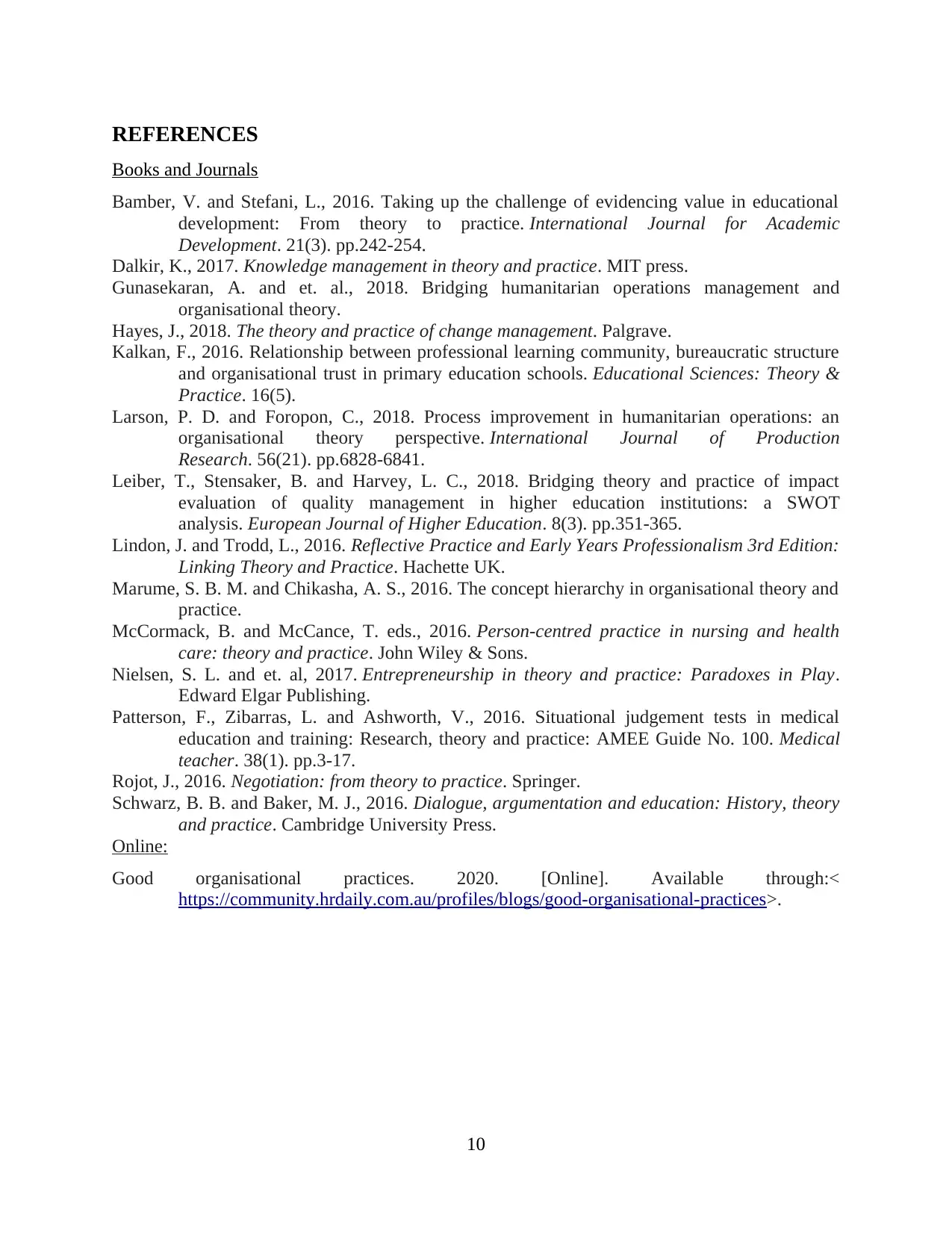
REFERENCES
Books and Journals
Bamber, V. and Stefani, L., 2016. Taking up the challenge of evidencing value in educational
development: From theory to practice. International Journal for Academic
Development. 21(3). pp.242-254.
Dalkir, K., 2017. Knowledge management in theory and practice. MIT press.
Gunasekaran, A. and et. al., 2018. Bridging humanitarian operations management and
organisational theory.
Hayes, J., 2018. The theory and practice of change management. Palgrave.
Kalkan, F., 2016. Relationship between professional learning community, bureaucratic structure
and organisational trust in primary education schools. Educational Sciences: Theory &
Practice. 16(5).
Larson, P. D. and Foropon, C., 2018. Process improvement in humanitarian operations: an
organisational theory perspective. International Journal of Production
Research. 56(21). pp.6828-6841.
Leiber, T., Stensaker, B. and Harvey, L. C., 2018. Bridging theory and practice of impact
evaluation of quality management in higher education institutions: a SWOT
analysis. European Journal of Higher Education. 8(3). pp.351-365.
Lindon, J. and Trodd, L., 2016. Reflective Practice and Early Years Professionalism 3rd Edition:
Linking Theory and Practice. Hachette UK.
Marume, S. B. M. and Chikasha, A. S., 2016. The concept hierarchy in organisational theory and
practice.
McCormack, B. and McCance, T. eds., 2016. Person-centred practice in nursing and health
care: theory and practice. John Wiley & Sons.
Nielsen, S. L. and et. al, 2017. Entrepreneurship in theory and practice: Paradoxes in Play.
Edward Elgar Publishing.
Patterson, F., Zibarras, L. and Ashworth, V., 2016. Situational judgement tests in medical
education and training: Research, theory and practice: AMEE Guide No. 100. Medical
teacher. 38(1). pp.3-17.
Rojot, J., 2016. Negotiation: from theory to practice. Springer.
Schwarz, B. B. and Baker, M. J., 2016. Dialogue, argumentation and education: History, theory
and practice. Cambridge University Press.
Online:
Good organisational practices. 2020. [Online]. Available through:<
https://community.hrdaily.com.au/profiles/blogs/good-organisational-practices>.
10
Books and Journals
Bamber, V. and Stefani, L., 2016. Taking up the challenge of evidencing value in educational
development: From theory to practice. International Journal for Academic
Development. 21(3). pp.242-254.
Dalkir, K., 2017. Knowledge management in theory and practice. MIT press.
Gunasekaran, A. and et. al., 2018. Bridging humanitarian operations management and
organisational theory.
Hayes, J., 2018. The theory and practice of change management. Palgrave.
Kalkan, F., 2016. Relationship between professional learning community, bureaucratic structure
and organisational trust in primary education schools. Educational Sciences: Theory &
Practice. 16(5).
Larson, P. D. and Foropon, C., 2018. Process improvement in humanitarian operations: an
organisational theory perspective. International Journal of Production
Research. 56(21). pp.6828-6841.
Leiber, T., Stensaker, B. and Harvey, L. C., 2018. Bridging theory and practice of impact
evaluation of quality management in higher education institutions: a SWOT
analysis. European Journal of Higher Education. 8(3). pp.351-365.
Lindon, J. and Trodd, L., 2016. Reflective Practice and Early Years Professionalism 3rd Edition:
Linking Theory and Practice. Hachette UK.
Marume, S. B. M. and Chikasha, A. S., 2016. The concept hierarchy in organisational theory and
practice.
McCormack, B. and McCance, T. eds., 2016. Person-centred practice in nursing and health
care: theory and practice. John Wiley & Sons.
Nielsen, S. L. and et. al, 2017. Entrepreneurship in theory and practice: Paradoxes in Play.
Edward Elgar Publishing.
Patterson, F., Zibarras, L. and Ashworth, V., 2016. Situational judgement tests in medical
education and training: Research, theory and practice: AMEE Guide No. 100. Medical
teacher. 38(1). pp.3-17.
Rojot, J., 2016. Negotiation: from theory to practice. Springer.
Schwarz, B. B. and Baker, M. J., 2016. Dialogue, argumentation and education: History, theory
and practice. Cambridge University Press.
Online:
Good organisational practices. 2020. [Online]. Available through:<
https://community.hrdaily.com.au/profiles/blogs/good-organisational-practices>.
10
⊘ This is a preview!⊘
Do you want full access?
Subscribe today to unlock all pages.

Trusted by 1+ million students worldwide
1 out of 12
Related Documents
Your All-in-One AI-Powered Toolkit for Academic Success.
+13062052269
info@desklib.com
Available 24*7 on WhatsApp / Email
![[object Object]](/_next/static/media/star-bottom.7253800d.svg)
Unlock your academic potential
Copyright © 2020–2025 A2Z Services. All Rights Reserved. Developed and managed by ZUCOL.




